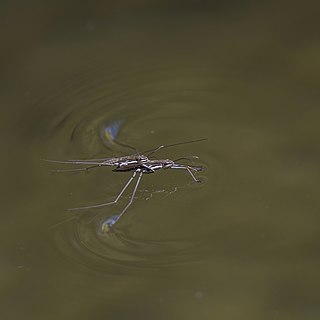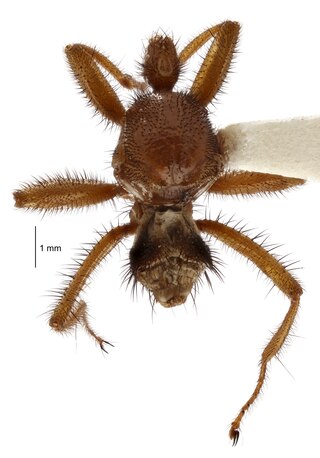
Fiordland is a geographical region of New Zealand in the south-western corner of the South Island, comprising the westernmost third of Southland. Most of Fiordland is dominated by the steep sides of the snow-capped Southern Alps, deep lakes, and its steep, glacier-carved and now ocean-flooded western valleys. The name "Fiordland" comes from a variant spelling of the Scandinavian word for this type of steep valley, "fjord". The area of Fiordland is dominated by, and very roughly coterminous with, Fiordland National Park, New Zealand's largest National Park.

The spotted shag or pārekareka is a species of cormorant endemic to New Zealand. Though originally classified as Phalacrocorax punctatus, it is sufficiently different in appearance from typical members of that genus that for a time it was placed in a separate genus, Stictocarbo, along with a similar species, the Pitt shag. Subsequent genetic studies show that the spotted shag's lineage is nested within the typical shags.

The Gerridae are a family of insects in the order Hemiptera, commonly known as water striders, water skeeters, water scooters, water bugs, pond skaters, water skippers, water gliders, water skimmers or puddle flies. Consistent with the classification of the Gerridae as true bugs, gerrids have mouthparts evolved for piercing and sucking, and distinguish themselves by having the unusual ability to walk on water, making them pleuston (surface-living) animals. They are anatomically built to transfer their weight to be able to run on top of the water's surface. As a result, one could likely find water striders present in any pond, river, or lake. Over 1,700 species of gerrids have been described, 10% of them being marine.

Sandfly or sand fly is a colloquial name for any species or genus of flying, biting, blood-sucking dipteran (fly) encountered in sandy areas. In the United States, sandfly may refer to certain horse flies that are also known as "greenheads", or to members of the family Ceratopogonidae. The bites usually result in a small, intensely itchy bump or welt, the strength of which intensifies over a period of 5-7 days before dissipating. Moderate relief is achieved with varying success through the application of over the counter products such as Benadryl (ingested) or an analgesic cream such as After Bite. Outside the United States, sandfly may refer to members of the subfamily Phlebotominae within the Psychodidae. Biting midges (Ceratopogonidae) are sometimes called sandflies or no-see-ums. New Zealand sandflies are in the genus of sand fly Austrosimulium, a type of black fly.

Phlebotomus is a genus of "sand flies" in the Diptera family Psychodidae. In the past, they have sometimes been considered to belong in a separate family, Phlebotomidae, but this alternative classification has not gained wide acceptance.

A black fly or blackfly is any member of the family Simuliidae of the Culicomorpha infraorder. It is related to the Ceratopogonidae, Chironomidae, and Thaumaleidae. Over 2,200 species of black flies have been formally named, of which 15 are extinct. They are divided into two subfamilies: Parasimuliinae contains only one genus and four species; Simuliinae contains all the rest. Over 1,800 of the species belong to the genus Simulium.

The Phlebotominae are a subfamily of the family Psychodidae. In several countries, their common name is sandfly, but that name is also applied to other flies. The Phlebotominae include many genera of blood-feeding (hematophagous) flies, including the primary vectors of leishmaniasis, bartonellosis and pappataci fever.

Lampides boeticus, the pea blue, or long-tailed blue, is a small butterfly that belongs to the lycaenids or gossamer-winged family.

The chorus cicada, Amphipsalta zelandica, is the most common species of cicada in New Zealand, where it is endemic and found in most areas. They typically live in forests and areas with open bush, where their left-over nymph skins can be seen on tree trunks and branches during the summer months. The males produce their cicada sound in unison, which can reach deafening proportions at the height of their population around February. Groups of cicada can suddenly transition from the typical cicada sound to synchronised clicks, using their wings to clap against the surface they are sitting on.

The New Zealand bat fly is a small, wingless insect which lives in a commensal relationship with the New Zealand lesser short-tailed bat. It is a true fly, in the order Diptera, placed in its own genus, Mystacinobia, and its own family, Mystacinobiidae. Although many other species of bat fly exist throughout the world, the New Zealand bat fly is endemic to the islands of New Zealand. It appears to be the only insect, parasitic or otherwise, which lives with these bats.

Austrosimulium is a genus of 31 species of black flies that are distributed in Australia and New Zealand. There are 2 subgenera: Austrosimulium whose species are principally from New Zealand, and Novaustrosimulium which are exclusively Australian. Austrosimulium is a sister genus to the monospecific Paraustrosimulium of South America.
Lutzomyia shannoni is a species of fly in the subfamily Phlebotominae, the phlebotomine sand flies. It is native to the Americas from the southeastern United States to northern Argentina. It has a disjunct distribution, and is only found in regions with suitable climates, habitat types, and host animals. It is well known as a vector of the vesicular stomatitis virus, which causes the disease vesicular stomatitis in animals, particularly livestock.

A gnat is any of many species of tiny flying insects in the dipterid suborder Nematocera, especially those in the families Mycetophilidae, Anisopodidae and Sciaridae. Most often they fly in large numbers, called clouds. "Gnat" is a loose descriptive category rather than a phylogenetic or other technical term, so there is no scientific consensus on what constitutes a gnat. Some entomologists consider only non-biting flies to be gnats. Certain universities and institutes also distinguish eye gnats: the Smithsonian Institution describes them as "non-biting flies, no bigger than a few grains of salt, ... attracted to fluids secreted by your eyes".

Austrosimulium is a subgenus of Austrosimulium, a genus of Simuliidae. The flies in this subgenre are found mainly in New Zealand, with a few in Australia. They are the only Simuliidae found in New Zealand.

Many species of flies of the two-winged type, Order Diptera, such as mosquitoes, horse-flies, blow-flies and warble-flies, cause direct parasitic disease to domestic animals, and transmit organisms that cause diseases. These infestations and infections cause distress to companion animals, and in livestock industry the financial costs of these diseases are high. These problems occur wherever domestic animals are reared. This article provides an overview of parasitic flies from a veterinary perspective, with emphasis on the disease-causing relationships between these flies and their host animals. The article is organized following the taxonomic hierarchy of these flies in the phylum Arthropoda, order Insecta. Families and genera of dipteran flies are emphasized rather than many individual species. Disease caused by the feeding activity of the flies is described here under parasitic disease. Disease caused by small pathogenic organisms that pass from the flies to domestic animals is described here under transmitted organisms; prominent examples are provided from the many species.

Chaetocoelopa littoralis, commonly known as the hairy kelp fly, is a fly of the family Coelopidae. It is endemic to New Zealand and is widely distributed around the coastline, including offshore islands. These flies are black in appearance and show large variation in size, with males tending to be larger and more robust and 'hairy' than females.

Exsul singularis, the bat-winged fly, is a species of fly that is endemic to New Zealand, first described by Frederick Hutton in 1901. The males have enormously expanded wings. The species is found in the south-western South Island and occurs mostly in high-altitude meadows near streams. It preys on soft-bodied flying insects and is believed to uses its wings to increase its body temperature to offset the cool temperatures of its alpine habitat.
Ichneutica prismatica is a moth of the family Noctuidae. This species is endemic to New Zealand. The species is ochreous coloured with distinctive pale streaks on its forewings and a white fringe on its hindwings. It is similar in appearance to I. paraxysta but I. prismatica is smaller, lighter bodied and has narrower wings. Also I. prismatica can only be found in the South Island where as I. paraxysta is only known from the North Island. I. prismatica has mainly be collected in the Central Otago region but has also been recorded in the Otago Lakes and the wider Dunedin regions. It inhabits tussock grasslands and wetlands. The life history of this species is unknown but the larval host species are found in the genus Chionochloa. Adults are on the wing in December and January and have been recorded as flying during the day.

Austrosimulium australense, known as the New Zealand black fly or more commonly sandfly, is a species of small fly of the family Simuliidae, endemic to New Zealand. Females consume blood for nutrients to produce eggs, and it is one of three species of Austrosimulium in New Zealand that often bite humans.

Phlebotomus papatasi is a species of insects commonly known as sandflies. Due to their ectothermic climate limitations, P. papatasi are confined to regions with temperatures above 15 degrees Celsius for at least three months of the year, spanning over much of the European Mediterranean, North Africa, the Middle East, and Central Asia. Around one thousand sandfly species have been described, belonging to the subfamily Phlebotominae within the family Psychodidae. The Psychodidae family belongs to the order Diptera within the class Insecta of the subphylum Hexapoda of the Arthropod phylum.

















